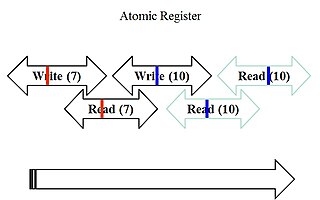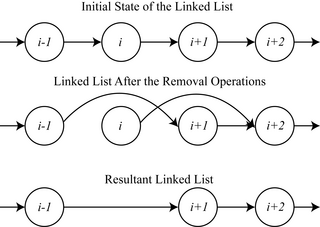
Atomic semantics is a type of guarantee provided by a data register shared by several processors in a parallel machine or in a network of computers working together. Atomic semantics are very strong. An atomic register provides strong guarantees even when there is concurrency and failures.
Regular semantics is a computing term which describes one type of guarantee provided by a data register shared by several processors in a parallel machine or in a network of computers working together. Regular semantics are defined for a variable with a single writer but multiple readers. These semantics are stronger than safe semantics but weaker than atomic semantics: they guarantee that there is a total order to the write operations which is consistent with real-time and that read operations return either the value of the last write completed before the read begins, or that of one of the writes which are concurrent with the read.
Safe semantics is a computer hardware consistency model. It describes one type of guarantee that a data register provides when it is shared by several processors in a parallel computer or in a network of computers working together.

In computer science, mutual exclusion is a property of concurrency control, which is instituted for the purpose of preventing race conditions. It is the requirement that one thread of execution never enters a critical section while a concurrent thread of execution is already accessing said critical section, which refers to an interval of time during which a thread of execution accesses a shared resource or shared memory.
In information technology and computer science, especially in the fields of computer programming, operating systems, multiprocessors, and databases, concurrency control ensures that correct results for concurrent operations are generated, while getting those results as quickly as possible.
Multiversion concurrency control, is a concurrency control method commonly used by database management systems to provide concurrent access to the database and in programming languages to implement transactional memory.
A database transaction symbolizes a unit of work, performed within a database management system against a database, that is treated in a coherent and reliable way independent of other transactions. A transaction generally represents any change in a database. Transactions in a database environment have two main purposes:
- To provide reliable units of work that allow correct recovery from failures and keep a database consistent even in cases of system failure. For example: when execution prematurely and unexpectedly stops in which case many operations upon a database remain uncompleted, with unclear status.
- To provide isolation between programs accessing a database concurrently. If this isolation is not provided, the programs' outcomes are possibly erroneous.
In computer science, a lock or mutex is a synchronization primitive: a mechanism that enforces limits on access to a resource when there are many threads of execution. A lock is designed to enforce a mutual exclusion concurrency control policy, and with a variety of possible methods there exists multiple unique implementations for different applications.
In databases and transaction processing, two-phase locking (2PL) is a concurrency control method that guarantees serializability. It is also the name of the resulting set of database transaction schedules (histories). The protocol uses locks, applied by a transaction to data, which may block other transactions from accessing the same data during the transaction's life.
In computer science, a consistency model specifies a contract between the programmer and a system, wherein the system guarantees that if the programmer follows the rules for operations on memory, memory will be consistent and the results of reading, writing, or updating memory will be predictable. Consistency models are used in distributed systems like distributed shared memory systems or distributed data stores. Consistency is different from coherence, which occurs in systems that are cached or cache-less, and is consistency of data with respect to all processors. Coherence deals with maintaining a global order in which writes to a single location or single variable are seen by all processors. Consistency deals with the ordering of operations to multiple locations with respect to all processors.

In concurrent programming, an operation is linearizable if it consists of an ordered list of invocation and response events, that may be extended by adding response events such that:
- The extended list can be re-expressed as a sequential history.
- That sequential history is a subset of the original unextended list.
In computing, a parallel programming model is an abstraction of parallel computer architecture, with which it is convenient to express algorithms and their composition in programs. The value of a programming model can be judged on its generality: how well a range of different problems can be expressed for a variety of different architectures, and its performance: how efficiently the compiled programs can execute. The implementation of a parallel programming model can take the form of a library invoked from a sequential language, as an extension to an existing language, or as an entirely new language.
Replication in computing involves sharing information so as to ensure consistency between redundant resources, such as software or hardware components, to improve reliability, fault-tolerance, or accessibility.
In concurrency control of databases, transaction processing, and various transactional applications, both centralized and distributed, a transaction schedule is serializable if its outcome is equal to the outcome of its transactions executed serially, i.e. without overlapping in time. Transactions are normally executed concurrently, since this is the most efficient way. Serializability is the major correctness criterion for concurrent transactions' executions. It is considered the highest level of isolation between transactions, and plays an essential role in concurrency control. As such it is supported in all general purpose database systems. Strong strict two-phase locking (SS2PL) is a popular serializability mechanism utilized in most of the database systems since their early days in the 1970s.
Causal consistency is one of the major memory consistency models. In concurrent programming, where concurrent processes are accessing a shared memory, a consistency model restricts which accesses are legal. This is useful for defining correct data structures in distributed shared memory or distributed transactions.
A fundamental problem in distributed computing and multi-agent systems is to achieve overall system reliability in the presence of a number of faulty processes. This often requires coordinating processes to reach consensus, or agree on some data value that is needed during computation. Example applications of consensus include agreeing on what transactions to commit to a database in which order, state machine replication, and atomic broadcasts. Real-world applications often requiring consensus include cloud computing, clock synchronization, PageRank, opinion formation, smart power grids, state estimation, control of UAVs, load balancing, blockchain, and others.
The Java programming language and the Java virtual machine (JVM) is designed to support concurrent programming. All execution takes place in the context of threads. Objects and resources can be accessed by many separate threads. Each thread has its own path of execution, but can potentially access any object in the program. The programmer must ensure read and write access to objects is properly coordinated between threads. Thread synchronization ensures that objects are modified by only one thread at a time and prevents threads from accessing partially updated objects during modification by another thread. The Java language has built-in constructs to support this coordination.
A concurrent hash-trie or Ctrie is a concurrent thread-safe lock-free implementation of a hash array mapped trie. It is used to implement the concurrent map abstraction. It has particularly scalable concurrent insert and remove operations and is memory-efficient. It is the first known concurrent data-structure that supports O(1), atomic, lock-free snapshots.
In distributed computing, a shared snapshot object is a type of data structure, which is shared between several threads or processes. For many tasks, it is important to have a data structure, that can provide a consistent view of the state of the memory. In practice, it turns out that it is not possible to get such a consistent state of the memory by just accessing one shared register after another, since the values stored in individual registers can be changed at any time during this process. To solve this problem, snapshot objects store a vector of n components and provide the following two atomic operations: update(i,v) changes the value in the ith component to v, and scan returns the values stored in all n components. Snapshot objects can be constructed using atomic single-writer multi-reader shared registers.
The Java programming language's Java Collections Framework version 1.5 and later defines and implements the original regular single-threaded Maps, and also new thread-safe Maps implementing the java.util.concurrent.ConcurrentMap interface among other concurrent interfaces. In Java 1.6, the java.util.NavigableMap interface was added, extending java.util.SortedMap, and the java.util.concurrent.ConcurrentNavigableMap interface was added as a subinterface combination.






